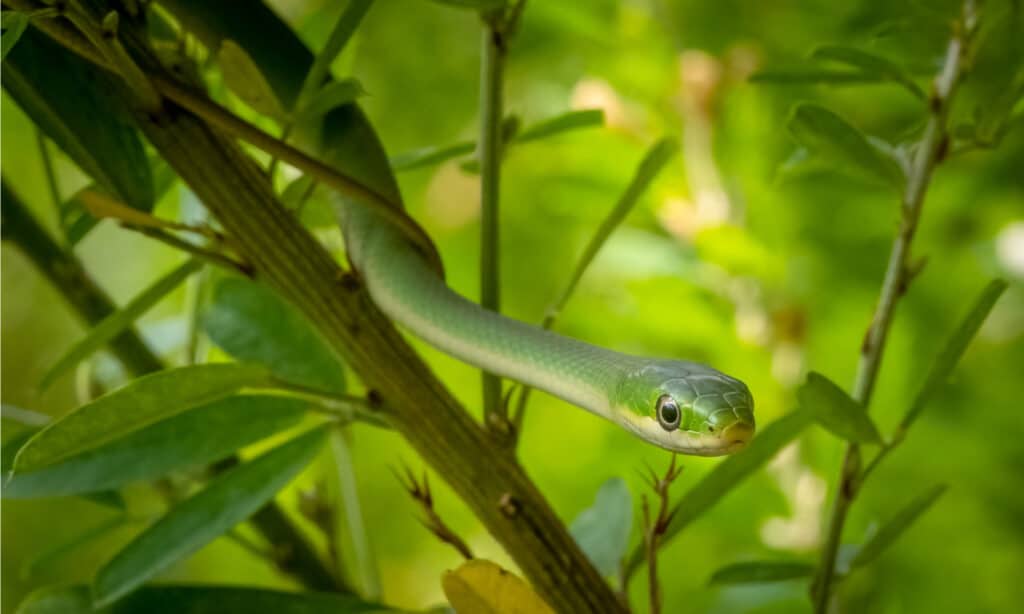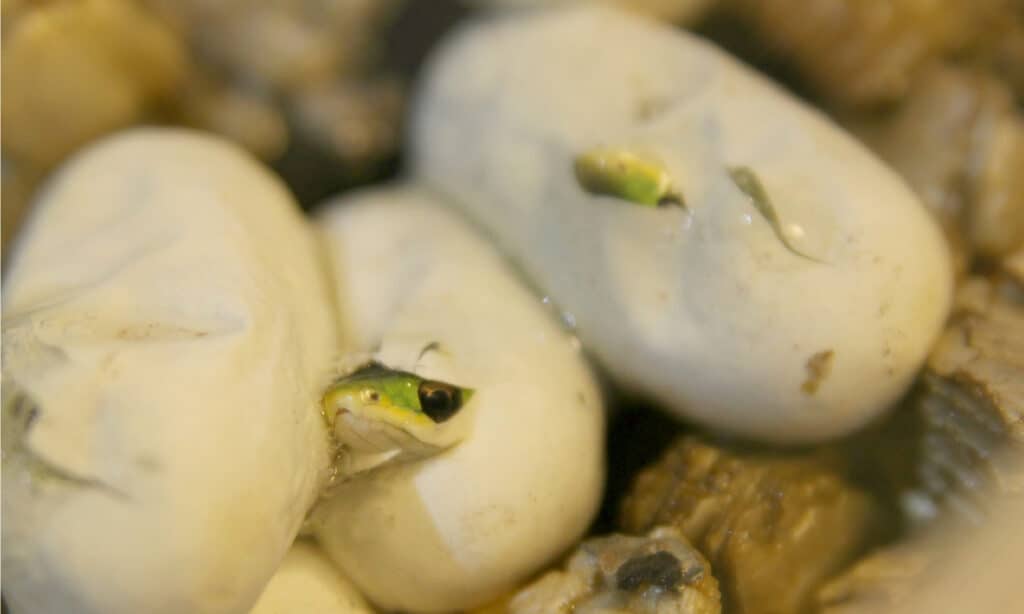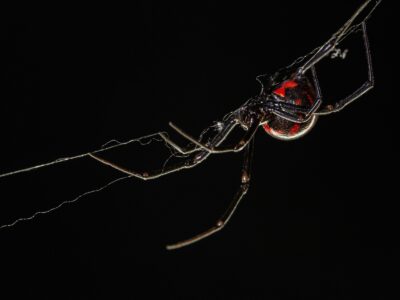Green Snake
.jumbotron {
background-image: url(“https://a-z-animals.com/media/2022/05/green-snake-in-tree-400×300.jpg”);
}
}
@media only screen and (min-width: 641px) and (max-width: 920px) {
.jumbotron {
background-image: url(“https://a-z-animals.com/media/2022/05/green-snake-in-tree-470×370.jpg”);
}
}
@media only screen and (min-width: 921px) {
.jumbotron {
background-image: url(“https://a-z-animals.com/media/2022/05/green-snake-in-tree.jpg”);
}
}
Green Snake
Opheodrys
There are two types of green snakes: smooth green snakes and rough green snakes
Green Snake Scientific Classification
- Kingdom
- Animalia
- Phylum
- Chordata
- Class
- Reptilia
- Order
- Squamata
- Family
- Colubridae
- Genus
- Opheodrys
- Scientific Name
- Opheodrys
Read our Complete Guide to Classification of Animals.
Green Snake Conservation Status
Green Snake Facts
- Common Name
- Green snake
Green Snake Physical Characteristics
- Color
-
- Green
- Lifespan
- 5-8 years
- Venomous
- No
- Aggression
- Low
This post may contain affiliate links to our partners like Chewy, Amazon, and others. Purchasing through these helps us further the A-Z Animals mission to educate about the world’s species..

Discover alligator-eating snakes, spiders larger than your phone, and 1000 more incredible animals in our daily FREE email.
View all of the Green Snake images!
“Green snakes feature beautifully bright green dorsal scales and help control insect populations in gardens, crops or wherever they live.”
Green snakes are the only solid, bright green snakes in North America and northern Mexico. The two subspecies making up the genus Opheodrys, the smooth green snake (Opheodrys vernalis) and rough green snake (Opheodrys aestivus), are nonvenomous and non-threatening to humans. Instead, they serve humans, gardens and agriculture well by feeding mainly on soft-shelled arthropods like spiders, crickets, grasshoppers, moths and butterflies. They also play a significant role in the ecosystem as food for their predators, including birds like crows and hawks, other snakes, foxes and raccoons.
5 Amazing Facts
- The genus Opheodrys includes two subspecies of green snakes, the smooth green snakes and the rough green snakes
- Both types of green snakes lay between 3 and 13 eggs per clutch
- The smooth green snake gets its name from its smooth dorsal scales of bright green
- The rough green snake is so-named because its green dorsal scales are rough in texture and appearance
- Of the two types of green snakes, the rough subspecies is lengthier in both size and lifespan
Where to Find Green Snakes
Green snakes live from southern Canada to northern Mexico, including within most states of the United States. In the U.S., their geographic range is from North Dakota, South Dakota, eastern Montana, Wyoming and Utah eastward, with eastern states having higher populations of the snakes. Both smooth and rough green snakes are basically non-existent in Washington, Idaho, Oregon, California, Arizona and Nevada. They are also not found in British Colombia or Alberta, being mostly from Saskatchewan eastward to the Atlantic coast.
button.pulse {
transform: scale(1); animation: pulse 2s infinite;
box-shadow: 0 0 0 0 rgba(11, 247, 25, 1);
}
@keyframes pulse {
0% { transform: scale(0.90); box-shadow: 0 0 0 0 rgba(11, 247, 25, 0.5); }
60% { transform: scale(1); box-shadow: 0 0 0 15px rgba(11, 247, 25, 0); }
100% { transform: scale(0.90); box-shadow: 0 0 0 0 rgba(11, 247, 25, 0); }
}
The snakes’ habitat is mostly in moist areas with lush greenery in which they can camouflage themselves and hunt for prey. Both smooth green snakes and rough green snakes like living near water sources, like ponds or lakes. But smooth green snakes live primarily on the ground in grasses, prairies, meadows, gardens, forests and other foliage. Their rough counterparts spend nights mostly up in trees, hedges and bushes off the ground and along a shoreline.
Because the snakes mate from spring to early summer and lay eggs from June to September, you are most likely to see full grown green snakes during the spring or summer. Smooth green snakes are most easily found in spring and rough green snakes are most easily found in summer. Juveniles are independent upon hatching in August or September. Overall, green snakes are active from April to October and hibernate during cold winter months. During that hibernation, usually from December to February at least, you will not typically find green snakes in the wild.
Scientific Name
The green snake is within the family Colubridae, subfamily Colubrinae and genus Opheodrys. The smooth green snake’s scientific name is Opheodrys vernalis and the rough green snake’s scientific name is Opheodrys aestivus. Opheodrys comes from the Greek word ophios meaning “snake” and drys meaning “tree.” Vernalis of the smooth green snake’s scientific name comes from the Old Latin vesnālis, meaning “spring.” Aestivus of the rough green snake’s name comes from the Latin aestivus, for “summer.”
The 2 Different Types of Green Snakes
Green snakes of North America and northern Mexico include two types. Originally, the species Opheodrys included classification of seven other types of green snakes. But two of these were transferred to the genus Cyclophiops in 1981. Both of those snakes are native to Asian geographies and are not found in North America or Mexico. Five other subspecies of Opheodrys in North America are no longer recognized as different from rough green snakes or smooth green snakes. These five are now grouped with the rough green snakes (Opheodrys aestivus) or smooth green snakes (Opheodrys vernalis).
The two distinct types of green snakes in North America and northern Mexico include:
- Smooth green snakes (Opheodrys vernalis) – Known to live in their ground habitats up to 6 years, smooth green snakes have smooth dorsal scales and reach lengths up to 26 inches
- Rough green snakes (Ophedrys aestivus) – Known to live in their tree habitats up to 8 years, rough green snakes have rough dorsal scales and grow up to 37 inches long
Population & Conservation Status
Both green snakes, smooth and rough, are listed as of “least concern” by the IUCN Red List of Endangered Species. The populations are also listed as stable.
The highest population counts of green snakes are in Texas, Oklahoma, Florida, Virginia and North Carolina. These states have at least hundreds of Opheodrys green snakes where counted, with Texas having nearly 2000 counted specimens in the wild. Other states and provinces of Canada range between low counts of tens or dozens to a few hundred per counted population. Only low counts of below 10 green snakes per population are found in northern Mexico.
How To Identify Green Snakes: Appearance and Description
Green snakes are typically bright green from nose to tail tip on the dorsal (back) side of their body. The sides are also the same color green. The snake’s belly is usually cream or yellow in color. A smooth green snake has a smooth appearance on its dorsal scales, while its rough green snake counterpart has a rough dorsal scale appearance and texture.
Juvenile snakes in this genus are often tan, brown or gray in color, growing more green as they develop. As a full-grown snake, the green body color can be a subdued green or a very bright, grassy or leafy color.
Green snakes are thin-bodied with females being larger than males. The two types range from 13 inches in length to 37 inches. Smooth green snakes are the smaller of the two types. The head of the snakes is only slightly broader than the neck and oval in shape.
How to identify a Green Snake:
- Bright green dorsal and side color for full-grown snakes
- Adults measuring between 13″ and 37″
- Yellow to cream underside color
- Oval shaped head only slightly broader than neck
- Juveniles sometimes tan, brown or gray in color
- Thin bodied
Green Snake Pictures

samray/Shutterstock.com

Stuart Hamilton/Shutterstock.com

samray/Shutterstock.com
How Dangerous Are They?
Green snakes are not dangerous or aggressive to humans. They are non-venomous and therefore not poisonous to people or pets. In fact, many people try to keep green snakes as pets, although it is difficult for captive green snakes to live long without professional care. If choosing a green snake as a pet, it is best to select a rough green snake and exercise great care with a veterinarian’s ongoing advice. According to many reports, smooth green snakes often will not eat in captivity and die from starvation.
Upon seeing a human or predator, a green snake will generally flee. If cornered or threatened, they sometimes thrash or bite. This is particularly true if held by a human. But the snakes do not have fangs and their bite is not poisonous. It should not cause injury to people or pets, such as cats or dogs. If you keep a green snake as a pet, you must take great care to handle it calmly. It takes time and persistent handling for a green snake to get used to being around people.
Green Snake Behavior and Humans
Green snakes are not venomous or aggressive to humans. They prefer to flee the area and hide upon sighting a human. The snakes do provide helpful service to people, particularly in the realm of pest control for gardens and crops. Green snakes feed on soft-shelled arthropods that damage plants like spiders, grasshoppers, crickets, butterflies and moths.
View all 115 animals that start with G
Green Snake FAQs (Frequently Asked Questions)
Are green snakes venomous?
Green snakes are neither venomous or poisonous. They hunt insects only using a fast sneak attack to get close to the prey, followed by slow, careful movements to capture their food. This does not involve any use of natural toxins and the snakes do not have fangs. Green snakes sometimes thrash around and bite defensively, but the bite is harmless.
How do green snakes hunt?
Green snakes hunt by first spotting their insect prey with their keen vision. They rapidly approach the insect, then slowly maneuver into position when close to it. When they reach about 3cm from the insect, the snake coils its body into a spring-like shape. Then they use lightning speed to straighten the body, propelling their head forward to the prey and taking it into their mouth.
Are green snakes aggressive?
Green snakes are not aggressive. They prefer flight over fights. Whenever possible, the snake will flee a threat from a human or predator. If they cannot flee, the snake will thrash around, whipping its body and tail while lashing out in bites. The bite rarely causes harm because the snake does not have fangs or harmful teeth.
Where do green snakes live?
Green snakes live in southern Canada, the United States and northern Mexico. They are not present in far western U.S. states, such as Washington, Idaho, Oregon, California, Arizona and Nevada. They are also not present in British Colombia or Alberta. The snake’s populations are greatest in Texas, Oklahoma, North Carolina, Virginia and Florida.
What do green snakes eat?
Green snakes eat soft-shelled arthropods. Their preferred prey include grasshoppers, spiders, crickets, butterflies and moths. They will sometimes eat other insects, like beetles, caterpillars, snails, slugs, centipedes and millipedes.
Is a green snake rare?
Green snakes are not rare and live in stable populations throughout North America. They are most populous in Texas, Oklahoma, Virginia, North Carolina and Florida. They are found through the United States and Canada, except in far western regions like Alberta, British Columbia, Washington, Oregon, Idaho, California, Arizona and Nevada. Some are also found in far northern Mexico.
What is a green snake called?
Green snakes are identified by their two types, the smooth green snake and rough green snake. The smooth green snake has smooth dorsal scales, whereas the rough green snake has rough dorsal scales.
Will a green snake bite you?
A green snake will bite if threatened and when it cannot flee as preferred. They bite most often when handled. These bites are not painful and rarely cause damage to humans or domesticated animals. Green snakes do not have fangs and are not venomous.
Where can I buy a green snake?
Rough green snakes are for sale at major pet retailers. But you cannot typically find smooth green snakes for sale because they are difficult to keep alive in captivity. Rough green snakes do better in a pet habitat and with human handling and are known to live up to 8 years as pets.
Can you have a green snake as a pet?
It is not recommended to keep a smooth green snake as a pet. The smooth type are hard to keep alive. Rough green snakes can be domesticated, however. You must feed them live insects and provide a proper habitat and veterinary care. But many people enjoy having these rough-scaled types in their home for up to 8 years, the average lifespan for a rough green snake in captivity.
Which is the largest green snake?
Rough green snakes are the largest green snake in the world of the true green snake family.
Sources
- Wikipedia, Available here: https://en.wikipedia.org/wiki/Opheodrys
- EOL, Available here: https://eol.org/pages/14049
- Animal Diversity, Available here: https://animaldiversity.org/accounts/Opheodrys_vernalis/
- Animal Diversity, Available here: https://animaldiversity.org/accounts/Opheodrys_aestivus/
- Nature Serve, Available here: https://explorer.natureserve.org/Taxon/ELEMENT_GLOBAL.2.103123/Opheodrys_vernalis
- Chesapeake Bay, Available here: https://www.chesapeakebay.net/S=0/fieldguide/critter/rough_green_snake
- University of Georgia, Available here: https://srelherp.uga.edu/snakes/ophaes.htm
- Univ. of Michigan, Available here: http://www.biokids.umich.edu/critters/Opheodrys_vernalis/
- Univ. of Florida Museum, Available here: https://www.floridamuseum.ufl.edu/florida-snake-id/snake/rough-greensnake/
- MSU, Available here: https://mnfi.anr.msu.edu/species/description/11517/Opheodrys-vernalis
- Outdoor Alabama, Available here: https://www.outdooralabama.com/non-venomous-snakes/rough-green-snake
- Spruce Pets, Available here: https://www.thesprucepets.com/care-of-smooth-and-rough-green-snakes-1239231
- Britannica, Available here: https://www.britannica.com/animal/green-snake
- Kid ADL, Available here: https://kidadl.com/animal-facts/smooth-green-snake-facts
- Kid ADL, Available here: https://kidadl.com/animal-facts/rough-green-snake-facts
- IUCN, Available here: https://www.iucnredlist.org/search?query=opheodrys&searchType=species















